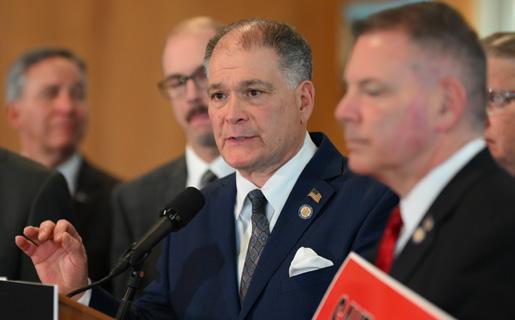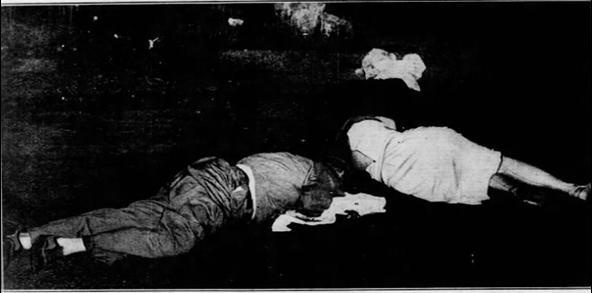






By

, marking a first in began printing
in January 2025 and quickly became a recognizable byline. But his work in local journalism goes back much further. Before joining the paper, he wore many hats at The Brookhaven News and The South Shore Press—writing, editing, and handling layout and
“I absolutely believe that Raheem is the right person to take the paper to the next level,” said former publisher Diane Caudullo, who officially passed the torch on Monday. “He understands how the business works—print, digital, advertising—and he really knows
Soto has lived in Suffolk County for thirty-five years, with the last twenty spent on the East End. Over the years, he’s covered town boards, school budgets, public safety, and elections—often
Continued on page 5
By Madison Warren
Mt. Pleasant Elementary School in Smithtown celebrated this week one of its most dedicated staff members. Rob O’Connor, the school’s head custodian, was honored by the PTA with the 2025 Honorary Lifetime Award in recognition of his twenty-one years of service to the district and eight years at the school.
Rob O’Connor was surprised with this award on June 26th by school principal Joseph Ierano, PTA president Carissa Mitchell, and his wife, as he thought was an ordinary “staff meeting.”. He received this award because of his exceptional dedication and contributions to the school community.
In announcing the award, Ierano spoke about Rob’s unwavering support and the countless ways he helps the school each day, saying, “So this person is someone who we call on hundreds of times a day to take care of us, to take care of all our needs, and that the PTA also relies heavily on all the events that they have to do for our student and teachers, all for good reason, but this year’s Honorary Life Award from the PTA goes to Mr. Rob O’Connor.”
Continued on page 3




Port Jefferson Summer Farmers Market at Harborfront Park
Mother's Day Brunch at Long Island Aquarium
May 11, 10:00 AM, 12:00 PM, 2:00 PM, 4:00 PM
May 18-Nov. 28 - 9:00 AM to 2:00 PM
Smithtown Village Summer Craft Fair
July 5, 10:00 AM to 5:00 PM
Bird and Breakfast at Connetquot State Park May 11, 8:00 AM to 11 :00 PM
Islip Farmers Market at Town Hall
June 7-November 22
Fleece and Fiber Festival at Hallockville Museum Farm
Summer Sundays Concert at Rocky Point Park
7:00 AM to 12:00 PM
May 17, 10:00 AM to 4:00 PM
July 6, 2:00 PM
Grooves on the Green in Ronkonkoma Every other
Nesconset Spring Fling May 18, 10:00 AM to 5:00 PM
Kings Park Rocks Main Street
July 7, 6:00 PM to 10:00 PM
Wednesday until Sept. 24, 5:00 PM to 7:30 PM
Jones Beach Air Show
May 24-25, 10:00 to 4:00 PM
Smith Haven Mall Carnival





Conveniently
PUBLISHER
Raheem Soto
EDITOR-IN-CHIEF
Matt Meduri
STAFF REPORTERS
Cait Crudden
ART PRODUCTION
MANAGER
Sergio A. Fabbri
GRAPHIC DESIGN
Colin Herr
CONTRIBUTORS
PJ Balzer
Ashley Pavlakis


Madison Warren
OFFICE MANAGER & ACCOUNTS
RECEIVABLE
Kim Revere
PROOFREADER
Giavanna Rudilosso
SOCIAL
Madison Warren









MANAGER
Tim Walz
PJ Balzer
Joe Cuminale






DELIVERY PERSONNEL
Colin Newman









Continued from front cover
By Madison Warren
Another coworker, when giving his award, said that Rob is always reliable at the school. The small acts he does might seem ordinary, but they are anything but. They show pride, care, and a deep sense of responsibility that makes this place more than just a building, and Rob helps it make a community.
His day-to-day responsibilities include keeping the school in top condition, from opening the building early each morning to handling repairs throughout the day to maintaining a spotless lunchroom. Whenever there’s a need, Rob is the one people call.
Rob also spoke about the crucial support he gets from his partner, Mike, who helps ensure everything runs smoothly even when Rob isn’t there.
“I worry about the school when I’m not here, but Mike is like my right arm, and we communicate. When you are off from here, you are not really off,” he said.
Rob has a deep love not just for the school itself, but for the students and teachers who stand by him. Even after the recent loss of his father, he returned to work just days later, dedicating himself entirely to his responsibilities. He said the outpouring of care and support from the staff truly moved him.
In addition to Rob being recognized, another teacher in the school was also honored a few weeks ago: third-grade teacher Melissa Clarkson. She has been a teacher at Smithtown for twenty-one years.

She said the best part of her job was the Smithtown community — whether it was seeing her students at the local store, bumping into parents on the soccer field, or building lasting friendships with her coworkers.
She received her award on June 18 because of her love and dedication to the district. When asked what she was feeling when she received her award, she said, “Just the feeling of knowing I work with such a great staff. We help each other. I just felt like I work hard, but I know everyone else does too. So I just felt super fortunate.”
Honored as well were Kristen Portigiano and Katilin Saar. Portigiano has chaired many events since her first child started at Mt. Pleasant in 2017.

Her chairmanship of programs include Kindergarten Orientation for over five years and the Square One Art fundraiser. She also spearheaded the school’s main entrance bulletin board, bringing creativity to over 210 bulletin boards during her tenure. She was also an eager volunteer at almost all PTA functions from 2017 to 2025.
Saar has lead Mt. Pleasant’s Arts in Education Program for six years, the past two of which she has led the program as Director for all Smithtown CSD’s PTAs. She has chaired the Beautification Committee since 2019. She continues her chairmanship of both organizations, accompanied by her role as Committee Chair of the Sweetheart Dance and Holiday Shoppe, among other volunteer necessities.
Rob, Melissa, Kristen, and Kaitlin have left a lasting impact not only on Mt. Pleasant Elementary School but on the entire Smithtown District.

By Matt Meduri
The summer months following the Fourth of July holiday is one of the most dangerous times of year on the roadways.
The Suffolk County Police Department (SCPD) is enhancing their presence on the roadways this weekend and throughout the summer to curb accidents and fatalities related to drunk/drugged driving.
“We are currently at 116 DWI-related arrests this year. Last year, it was 209,” said Sheriff Errol Toulon (D). “We’re now halfway through the year. We’re on pace to not only shatter that record, but take a lot of people off the road who could endanger others.”
Toulon was joined by County Executive Ed Romaine (R-Center Moriches) (pictured right) and Suffolk County Legislator Chad Lennon (C-Rocky Point) (pictured left).

“Although Albany may not take it seriously, I can guarantee you here in Suffolk County, we will take it seriously. We want our neighborhoods safe,” said Lennon. You have the choice. You can decide to not be pulled over. You can decide to not be prosecuted. You can decide to save a life by not getting behind the wheel of that car or boat.”
of summer is to be smart. Have a plan before you drink.”

Carl Borelli, Chief of the Vehicular Crimes Bureau of the Suffolk County District Attorney’s Office, also took issue with Albany’s inaction on the Drugged Driving Bill.
“It would be nice if our State Legislature would pass simple, commonsense legislation. It would eliminate the requirement for law enforcement to have the name of a drug on an antiquated list before they charge somebody for driving under the influence of drugs,” said Borelli. “The leadership in our Legislature would not even allow this bill to come into its force. As appalling and disheartening as that might be, it must not and cannot stop us.”
Borelli also takes issue with distracted or reckless driving.
“Put the phone away; don’t drive like a maniac on the roads,” said Borelli. “We see this all the time, people driving at high speeds, weaving in and out of traffic, blowing stops and red lights. It must stop.”
Borelli also says that there’s practically no excuse for driving impaired, as the current era has treated the public to ridesharing services and instant communication with family and friends.
Romaine and Toulon both take issue with the State Legislature’s lack of action in closing loopholes in the current drug laws and legislation that has kneecapped law enforcement’s and prosecutors’ abilities in curbing these types of crimes.
“It’s almost as if the laws of the state favor the lawbreaker and not the law enforcer. And that’s a shame,” said Romaine. “Shame on the majority in the Legislature and shame on our Governor.”
Romaine said that Suffolk “stands out” because the County is “enforcing the laws as they currently exist to the maximum extent possible.”
“We need changes at the State level to help protect the citizens of all of New York State, not only Suffolk County. And I’m hoping that the Governor and the Legislature will eventually do that,” said Romaine.
“They’re [Albany] not making our communities safe,” said Toulon (pictured right). “They’re making law enforcement’s job a lot more difficult.”

Toulon adds that while alcohol has long been a “scourge of the past”, enforcement becomes even more difficult with the legalization of recreational marijuana.
Another issue is that of New York’s list of substances that must be consulted when a driver suspected of being intoxicated is pulled over. If the intoxicating substance cannot be identified, the driver cannot be arrested. New York is one of four states with the “archaic” list, according to Romaine.

Emily Cordano (pictured left), of the Andrew McMorris Foundation, has worked to lobby New York for stricter laws in honor of her friend, Andrew McMorris, a Boy Scout who was killed while hiking with his troop in Manorville in 2018. Thomas Murphy was driving under the influence and veered his car into the troop.
“I felt hopeless and helpless; I couldn’t process it,” said Cordano of her reaction at the time. Now, 19, she has spoken and worked on the foundation’s behalf to rectify State laws pertaining to the matter. She is also an intern for the SCPD and the Suffolk County Sheriff’s Department.
“As an intern, I sat through many lectures about DWIs. The biggest takeaway I’ve learned from the officers was that there are not bad people, but people who decided to make bad choices,” said Cordano. “Deaths from driving under the influence have increased by 31% over the past decade. Drunk driving has killed more than 13,000 people a year for the second year in a row. All I ask is that one this 100-day stretch
“I would much rather get a call to pick up somebody than the alternative,” said Borelli.
Paige Carbone, Regional Executive Director for Mothers Against Drunk Driving (MADD) (pictured right), called the numbers not just “statistics”, but “lives.”
“Drinking impairs judgment, slows our reaction time, and increases the risk of deadly crashes. Getting behind the wheel after drinking can turn a fun night into a tragedy, and it’s not just about the legal consequences, it’s about the human cost,” said Carbone, adding that anyone drinking should be aware of its limitations when operating not just vehicles, but boats, jet skis, ATVs, or golf carts.
“If you are hosting a party, please look out for your guests. If you see a friend trying to get behind the wheel after they’ve been drinking, step in,” said Carbone. “You could be the person who saves their life and someone else’s life. That’s what real friends do.”
Caroline Flynn, of Stop DWI (pictured right), said that the new freedoms obtained by young people should be deterrents of driving under the influence.
“They’re graduating, going to college, getting their first jobs, and living on their own,” said Flynn. “It’s probably not going to happen if you get a DWI. Think twice.”



Continued from front cover
Founded in the 1880s, The Messenger has long been a fixture in Suffolk County’s media landscape. Based in Ronkonkoma, it covers government, schools, business, and breaking news across all hamlets and villages within Smithtown, Brookhaven, and Islip, as well as county-wide, statewide, and national news pertinent to the towns of coverage.
Soto takes over at a time when local newspapers across the country are shrinking or folding. His approach isn’t about dramatic reinvention—it’s about reinforcing what works.
“We’re not trying to be flashy,” said Soto. “We’re trying to be dependable. People still want solid reporting on the things that actually affect their lives—local taxes, school votes, crime in their neighborhood. That’s what we’re here for.”

The Messenger’s Editor-in-Chief, Matt Meduri, shares the anticipation of stepping into the next chapter of the paper’s history.
“We’ve done something relatively unthinkable in the modern era: making a newspaper grow. We’ve


captured something so far; now the task is to take it to the next level in terms of size and scope,” said Meduri. “Raheem Soto has worked every position imaginable in the paper business. We couldn’t have someone more intimately acquainted with the process to climb aboard and help us bring this operation to full steam.”

In addition to managing the weekly print edition, Soto is focused on expanding the paper’s digital footprint—improving social media reach, growing subscriptions, and rebuilding relationships with local advertisers.

He’s also spending time outside the office—reconnecting with business owners, veterans groups, civic associations, and longtime subscribers.

“This paper has always been about real people and real stories,” he said. “We’re going to keep showing up. That’s how you earn trust.”





Email us at: editor@ messengerpapers.com
We’d love to hear from you.







Governor Kathy Hochul’s (D-NY) recent decision to order State power and public works authorities to fast-track at least one nuclear reactor to power up to roughly a million homes within fifteen years is a laudable decision and goal. If clean energy is appealing, then this is certainly a viable option that would effectively and costefficiently help us bridge the gap to fully renewable, non-polluting energy.
The current bridges are still coal, oil, and natural gas, serving as modern “Stone Age to Bronze Age” placeholders until the next epoch arrives. Wind and solar are the pieces of the puzzle, but it’s not the landmark energy source some think they will be. Solar certainly has more potential than wind, but with expensive drawbacks on its own. This isn’t to say it shouldn’t be pursued, especially in local amounts, but trying to apply it to a national grid just isn’t feasible on its own.

Moreover, we’ve observed less of a buzz about these power sources on the national scale in recent years. Could it be over-promising and under-delivering on the part of the scientists and politicians who lobbied for it? Could it just be that technology has rapidly advanced in unparalleled ways that they already seem outclassed?
Whatever your take may be, it’s clear that some “bigger fish” must come along, and before we can fully adapt to a likely successor in hydrogenbased energy, a “slightly bigger fish” must come first.
Nuclear energy has certainly had a turnaround itself in allure. The meltdowns in Chernobyl and Fukushima and the incident at Three Mile Island are now far in the rearview mirror, and science and technology have only progressed since then.
Nuclear has its own drawbacks as well, the most concerning being meltdowns, malfunctions, and radiation. These disasters are certainly as rare as they are severe, and some researchers hypothesize that should a nuclear accident occur, it would have greater odds of turning out like Three Mile Island - long-term effects being more or less negligible - than Chernobyl.
So, we can call this initiative a “win” for Governor Hochul, but much more work is needed to effectively put New York back on the right track as far as energy goes.
The first would be the logical decisions in opening two pipelines: Constitution, which sources from Pennsylvania and would track through Upstate to New England; and the Northeast Supply Enhancement (NESE), which sources from the South and would power Suffolk, Nassau, Queens, and Brooklyn.
This accomplishes two goals: allows us to get back on par as far as our grid requirements go, and alleviates the environmental issues of trucking natural gas from Pennsylvania. Hundreds of these trucks put strain on NYS highways, while spewing exhaust into the air, only to require further energy
consumption to liquefy the frozen natural gas they’re shipping.
A pipeline greatly expedites this process and would at the very least get us breaking even with demands.
The other problem that’s easily solvable is repealing the deadlines in the Climate Leadership and Community Protection Act (CLCPA) and similar legislation. The CLCPA bans the construction of new fossil fuelpowered buildings under seven stories by the end of this year. By 2029, the ban will apply to all new structures in the state.
This is a goal probably more in line with decades from now, if that. It’s one thing to shoot for lofty goals and ask big, but it’s another to pragmatically see the forest for the trees. We’re simply not there yet. In Senate Energy and Telecommunications Committee Chairman Mario Mattera’s (R-St. James) words, it’s putting the cart before the horse.
We also agree with the Senator’s sentiments that the CLCPA’s deadlines would have to be put on hold to make way for the nuclear plant - if one reactor can even be operational in fifteen years. Some say it could take another twenty-five years before we’re generating at least one gigawatt of power - enough to power anywhere from 750,000 to one million homes - from nuclear energy.
If the CLCPA’s deadlines are to be fully implemented in just four-to-five short years, we’re already way behind schedule as far as energy goes - and that’s assuming the two pipelines aren’t operational.
Overall, this move is well-intentioned and the object of it is pragmatic, but it’s too little too late. Hochul likely senses the political winds shifting and is trying to cram for the test the night before. We won’t disagree with the plan either; it’s a reasonable foray into something that could put our state on the right path - even if those results aren’t realized in another generation. A win is a win.
But New York needs to sort out its priorities. It’s unfortunate; Hochul does have some good ideas from time to time, but she’s not a good executive. She can’t work with the legislature and apparently chooses not to dissent with her political machine, despite many of their choices gradually resulting in a tectonic rightward shift in the Empire State last year. Albany’s pragmatism - or lack, thereof - has gone unchecked due to a weak executive and a de facto power vacuum in Albany.
It reminds us of when our eyes are too big for our stomachs. It all seems like a great idea at first, until we realize what we were truly in for. Had we seen the end result, we would have ordered differently.
And in government, the trumpet of consequence rarely plays a lullaby.
If anything, we’re ever so slightly getting back on the right track, but it takes removed phase-out deadlines, better energy production bridges in the meantime, and the support over the years as the Governor’s mansion inevitably sees turnover.
By the time you read this, the fireworks are over, the grills have cooled off, and life is returning to normal.
But the truth is, the real substance of what we mark on the Fourth of July doesn’t stop on July 5. This paper has understood that for a long time.
Since starting as the Smithtown Messenger in 1887, it’s been here through wars, economic swings, and countless local disputes—always with the same conviction: people make better decisions about their communities when they know what’s happening.
You can still see that up and down Suffolk County. It’s small business owners taking risks with their own money, not someone else’s. It’s parents and neighbors who show up to see where tax dollars are going and what’s happening in our schools. It’s volunteer firefighters and law enforcement who give up family time to keep others safe. It’s kids on local fields after
school learning lessons in effort and discipline, with stands full of families who understand that showing up matters.
At The Messenger, our purpose isn’t complicated. We’re here to keep you informed about what’s happening in our towns, our schools, and with the people who give this place its character. It might not always be dramatic enough to lead national broadcasts, but it’s often more critical. I’m honored to carry that work forward.
Thank you for reading, for supporting local journalism, and for recognizing—like I do—that the freedoms we just celebrated are upheld far more by everyday choices and responsibilities than by any fireworks display.
Raheem Soto, Publisher
The Messenger Papers
By Assembly Minority Leader Will Barclay
Earlier this week, Governor Kathy Hochul (D) directed the New York Power Authority to develop and execute a plan to build a “zero-emission advanced nuclear power plant” at a to-be-determined location in Upstate New York. I applaud this decision, and I am glad to see the governor finally acknowledging the need to bolster our grid’s reliability with nuclear energy, just as the Assembly Minority Conference has repeatedly called for since the passage of the deeply flawed Climate Leadership and Community Protection Act (CLCPA).
Per the governor’s announcement, “candidate locations will be assessed for suitability based on public safety, strength of community support, compatibility with existing infrastructure, as well as skilled labor and land availability.” As I recently pointed out, Oswego already houses three reactors, and I believe it would be an ideal site for the proposed facility. I look forward to working with our partners in the executive’s office, state agencies and labor partners to develop a plan that works for all New Yorkers.
The decision to build an advanced nuclear power plant could not come soon enough. New York’s climate agenda has been on the wrong track for too long. The decommissioning of the two reactor plants at Indian Point—which supplied New York City with about 25% of its daily energy—combined with plans to phase out traditional natural gas as we electrify our energy grid and the unrealistic emissions goals of the CLCPA have raised numerous alarms statewide. At some point, Albany’s “green scheme” had to give way to reality. The commitment to nuclear power is a great first step toward addressing the shortcomings of the CLCPA, but we have much more work to do if we are truly going to modernize our energy infrastructure.
Nuclear energy is clean, efficient and reliable, and it is indispensable if New York is going to have a diverse energy portfolio capable of handling our substantial demand. Recently, the New York Independent System Operator (NYISO) released a report highlighting the need to improve the reliability of our energy infrastructure. According to NYISO, consumers’ increasing demand for electricity combined with New York taking
traditional power plants offline is resulting in declining reliability margins.
This week’s heat wave highlighted the need for proven, reliable power sources rather than a stubborn rush to alternative supplies. As temperatures rose across the state, NYISO was forced to issue an Energy Warning, which immediately precedes a full-blown Energy Emergency. With the grid approaching peak capacity, the governor encouraged New York City residents to set air conditioning units to 76 degrees and avoid “unnecessary appliance use.” Should our energy grid fail during a heat wave of this magnitude, or should it fail during similarly extreme winter weather, the situation could turn deadly.
Construction of a new nuclear facility would mark an exciting milestone for our state. I have long advocated for improvements to our energy infrastructure, and I truly believe we have a unique opportunity to not only meet our state’s energy needs but exceed them with a modern, affordable and efficient energy plan driven by nuclear power. I am excited to build upon this momentum and continue to find innovative ways to keep the lights on for generations to come.
If you have any questions or comments on this or any other state issue, or if you would like to be added to my mailing list or receive my newsletter, please contact my office. My office can be reached by mail at 19 Canalview Mall, Fulton, NY 13069 and by email at barclayw@nyassembly.gov. You may also find me, Assembly Minority Leader Will Barclay, on Facebook or Twitter at @WillABarclay.
Assemblyman Will Barclay (R-Pulaski) is the Assembly Minority Leader and has represented the 120th Assembly District since 2003. The 120th District contains most of Oswego County and parts of Cayuga and Jefferson counties.

By Tracey Alvino
Andrew Cuomo (D) thought he could rise from the ashes. He thought that after scandal, cover-ups, and resignation, he could walk back into the political arena and reclaim his relevance—this time as New York City’s mayor.
Instead, he got crushed. And not just by the voters—but by a Democrat Party that has outgrown him. Or rather, a party that has been hijacked by its most radical wing.
Cuomo’s downfall in the NYC mayoral race isn’t just personal karma (though there’s plenty of that). It’s symbolic. It marks the official end of the centrist Democrat— the party figure who once believed in the working people, law-and-order, balanced budgets, and incremental progress. That era is over. Dead. Buried.
The far left runs the show now.
Today’s Democrat Party isn’t the party of JFK, Bill Clinton, or even Barack Obama. It’s the party of TikTok activists, DSA influencers, and socialist city council members who think landlords are villains and the police are the enemy. It’s no longer about building bridges—it’s about burning them down.
And Andrew Cuomo, with billionaire bucks and corporate connections, was a walking fossil from a different time. The party didn’t just reject him—it made an example of him. If Cuomo—a three-term governor with deep connections and name recognition—can’t survive a primary in his own backyard, no centrist Democrat is safe.
Democrats used to win by capturing the center. Now, capturing the Twitter algorithm through fun social media clips seems more important than governing. Cuomo’s loss makes one thing clear: if you’re not marching in ideological lockstep with the far-left agenda, you’re the enemy.
Zohran Mamdani, the likely next mayor of New York City, signals a troubling shift in the city’s political direction. His unapologetically anti-police, pro-Palestinian, and openly socialist views—paired with a magnetic charisma—have earned him strong backing, especially among younger and wealthier voters. In today’s political climate, it’s not surprising that such views have gained traction; the far-left has steadily tightened its grip on the city’s political institutions, pushing aside more moderate voices.
Meanwhile, the political fallout from Andrew Cuomo’s mishandling and coverup of thousands of COVID-related nursing home deaths should have ended his influence in state politics. Yet, the Democratic Party’s decision to back Mamdani over more moderate and pragmatic leaders, such as NYC Council Speaker Adrienne Adams, reflects a profound failure in judgment. Now, the consequences of that choice are theirs to bear.
For those moderate Democrats still clinging to relevance, consider this a wake-up call. The progressive wing isn’t interested in compromise or coalitionbuilding. They’re here to purge you in the most painful, humiliating way possible.
The question isn’t whether the center can hold. It’s whether it even exists anymore.
Tracey Alvino is the Director for Voices for Seniors.

To the Editor,
On Long Island, earning a paycheck doesn’t always mean making ends meet. That’s why it’s worth recognizing when a member of Congress—like Andrew Garbarino—takes a stand for working families by supporting the Community Services Block Grant (CSBG). CSBG is a trusted, bipartisan, anti-poverty program that supports local agencies such as the Economic Opportunity Council of Suffolk,
where I serve as President and CEO.
In a high-cost region like ours, families who earn just above traditional poverty guidelines are often one unexpected expense away from crisis. The policy of continuing eligibility for households earning up to 200 percent of the federal poverty line ensures that working people who are struggling— even if they don’t meet traditional poverty thresholds—can still access critical supports like job training, housing assistance, child care, and health services.
CSBG is a uniquely effective program. Community Action Agencies like ours understand their communities and can deliver customized solutions. Here at EOC of Suffolk, CSBG supports everything from helping youth at risk of gun violence, to fighting homelessness, to connecting seniors with life-saving services, and more.
As Board President of the National Community Action Foundation, I’ve seen the impact of this funding across the country— and I know what we stand to lose without it.
That’s why I urge Congress to pass H.R. 3131, which will reauthorize and strengthen CSBG for years to come.
Community Action works. Let’s protect it.
Sincerely,
ADRIAN FASSETT President and CEO, Economic Opportunity Council of Suffolk, Inc. Board President, National Community Action Foundation
By Matt Meduri
In a turn of events regarding the state’s direction with green energy, Governor Kathy Hochul (D) is directing the New York Power Authority (NYPA) and the New York Department of Public Service (DPS) to develop “at least one new nuclear energy facility with a combined capacity of no less than one gigawatt of electricity, either alone or in partnership with private entities.”
Nuclear energy has been a mostly taboo topic in the decades following notable disasters, such as Chernobyl and Three Mile Island. However, as international debate swirls around green energy alternatives, nuclear energy is now making its way back into the picture, with decades of research, development, and education having been collected to pitch energy development with no greenhouse gases and a long-term low-cost outlook.
Hochul says that the NYPA would begin evaluating “technologies, business models, and locations” for the first plant, hoping to have nuclear power in fifteen years.
However, this calls into question the retention of certain renewable energy mandates passed in recent years. New York has imposed a statutory mandate for 100% carbon-free electricity by 2040 with the current goal of 70% carbon-free power by 2030. The New York State All-Electric Buildings Law says that by December 31, 2025, new buildings of seven stories or less will be prohibited from installing fossil fuel - primarily oil and natural gas - equipment and appliances. By January 1, 2029, the prohibition will extend to all new buildings.
The two initiatives are seemingly at odds with each, especially as consternation remains between the State and federal governments regarding offshore wind.
Weighing in on the matter is Senator Mario Mattera (R-St. James), Ranking Member of the Energy and Telecommunications Committee.
“Nuclear is a way to generate clean energy, but where would the plant go?” Mattera told The Messenger. “A nuclear plant will never be built on Long Island; we will never see a nuclear power station here. I worked at the Shoreham Nuclear Power Plant when it was being built and when it was shut down and dismantled because there was no evacuation plan.”
However, Mattera says that he, in good conscience, cannot dictate where a nuclear plant should be built, given it would happen outside of his district.
“There must be complete community awareness if anything is proposed; it can’t be a sneak attack,” said Mattera. “Environmentalists are already in an uproar about it.”
Environmentalists take issue with the proposal as counterproductive to the clean energy goals of the State. They believe that a nuclear plant is a dirty, dangerous, and expensive alternative that will delay renewable energy projects to help the State meet its self-imposed goals.
“We’d be lucky if this even took twenty years to happen,” said Mattera, criticizing the timeline as far too short to be implemented. “I’m hearing from experts that one of these reactors could take twenty-five years until it would be operational. That’s still not helping with our mandate in 2030. Governor Cuomo (D) should have never shut down Indian Point. He did it to bow down to the environmentalists.”
Indian Point Energy Center (IPEC) was a three-unit nuclear power station in Peekskill, Westchester County. Governor Cuomo ordered the plant to be shut down in 2021. Mattera says that his colleague and Energy and Telecommunications Committee Chairman,
“That’s a pretty decent size,” said Mattera. “But the Climate Leadership and Community Protection Act (CLCPA) says that you won’t be able to purchase a new boiler, gas stove, or gas ovens. All the surrounding states will sell them though.”
Mattera says that multiple local agencies and unions have joined the lawsuit against the CLCPA, including Plumbers Local 200, the International Brotherhood of Electrical Workers (IBEW), the Long Island Building Industry (LIBI), and the New York Propane Gas Association.
Instead, Mattera says Hochul’s plan should consist of putting the CLCPA and other related deadlines on hold while the nuclear power plan takes its course. Meanwhile, two natural gas pipelines could alleviate infrastructure strain and decrease CO2 emissions.
“Bring in the Constitution Pipeline and the Northeast Supply Enhancement (NESE) Pipeline,” said Mattera, with the former originating in Pennsylvania to power Upstate and New England and the latter originating in the South to power geographic Long Island.
“Hundreds of tanker trucks of frozen natural gas go up and down our highways. They’re spitting CO2 into our air, using energy to liquefy the natural gas, and then pumping it into a system that already has a capacity shortage.”
Mattera points to just last week’s heat wave as a point of capacity shortage, adding that about 40% of New York’s electric energy is coming from out-of-state transmission, such as Pennsylvania, Connecticut, and New Jersey. Mattera also says that Long Island’s “antiquated” energy infrastructure needs to be reworked to handle the demands imposed by the CLCPA, and that the current “gas capacity” is currently insufficient for just the East End alone.
“We need to re-tool our existing power plants with carbon capture. That’s the most inexpensive and economical way of handling our renewable energy needs for our future,” said Mattera. Carbon capture is the practice of reducing CO2 emissions by preventing them from entering the atmosphere. Instead, the CO2 is captured at its source and utilized for various products, such as fuels, chemicals, and building materials.
“I’ve been pushing for re-tooling our existing plants with carbon capture. Senator Parker has a bill to do something with that, but we didn’t have enough time in session. I’ll be working on that to bring such a bill to the floor in January,” said Mattera, adding that he is in favor of innovative methods of green energy, such as green hydrogen experiments being conducted at Brookhaven National Laboratory (BNL).
“That’s the place that does the experiments and has the most sophisticated scientists in the world. For us to move forward, we need to re-tool our existing plants,” said Mattera. “The Governor has done nothing to add money in her budget to retrofit our antiquated grid. Our grid can’t handle all-electric; it’s the cart before the horse. She’s done nothing to invest in revamping the grid for all-electric. Zero.”
Mattera also says the energy problem is multi-faceted. Wind and solar are “okay”, in his opinion, as they don’t give enough energy to meet the grid’s demands. More electric power would require battery storage facilities, on which the Towns of Smithtown, Huntington, and Islip have placed moratoriums. Mattera says such facilities would cost “trillions.”
“The Governor is trying to appease everyone for renewable energy in the future; fifteen years for a nuclear reactor would be a blessing if that could happen,” said Mattera. “But she has a lot of hurdles before this could even be proposed to go in anyone’s district. It’s

By Matt Meduri
National
Sunday morning saw the 2026 Senate cycle shakeup.
The Senate showdown for the fate of President Donald Trump’s (R-FL) “Big Beautiful Bill” has been defined by key Republican holdouts. With a slim majority of 53-47, the GOP can only afford three holdouts in order for Vice President J.D. Vance (R-OH) to cast tie-breaking votes. It has been reported that Trump has successfully courted the votes of Senator Ron Johnson (R-WI) and notable maverick Senator Lisa Murkowski (R-AK).
The bill passed late Saturday night in a 51-49 in the upper chamber. Fiscal watchdog Senator Rand Paul (R-KY) voted against it, as did Senator Thom Tillis (RNC), who cited cuts to health insurance for his state’s constituents.


Shortly thereafter, Tillis announced his retirement from the Senate; his seat is already up for re-election in 2026.
North Carolina starts out as one of the three key toss ups of the 2026 Senate map, along with Georgia - oneterm Senator Jon Ossoff (D-GA) is running for re-election - and Michigan - Senator Gary Peters (D-MI) is retiring.
North Carolina has also been a key swing state in every other political media, having been decided by less than five points in each presidential race since 2008, also the last time a Democrat has won the state’s electoral votes.
Additionally, the last time a Democrat won a U.S. Senate election in the Tar Heel State was the same year2008.
The drought has only been by a collective razor-thin margin for Democrats lately. Every election for the Class II seat - Tillis’ seat - has been decided by less than ten-point margins since 1972, with Tillis’ 2014 and 2020 elections being decided by less-than five-point margins. Tillis was also considered an underdog to beat Senator Kay Hagan (D-NC) in 2008 and even more so an underdog in 2020 to Cal Cunningham (D-NC).
To make matters worse for the GOP, top Democrats are keen that they can successfully recruit former twoterm Governor Roy Cooper (D-NC) to run for the seat. Cooper flipped the governor’s mansion blue in 2016 and was re-elected by a five-point margin in 2020. He was term-limited for office in 2024.
Cooper was already seen as the best-positioned nominee for this seat, with his possible inclusion warranting a “Toss Up” rating from major forecasters. Now, with the open-seat dynamic, many could shift their ratings into a favorable one for Democrats.
Democrats start the cycle as highly unlikely to flip back control of the Senate. Doing so would need a net gain of four seats, a tough climb with few options on table. North Carolina is a necessity in taking back the Senate, but the likeliest path to a majority would include taking now-open North Carolina, and picking off incumbents Susan Collins (R-ME), Joni Ernst (R-IA), and one other red seat. Based on recently-close races, Montana, Kansas, Nebraska, Texas, or Alaska could pan out.
But these are institutionally red states, and while Collins is in a blue state, she’s a well-known maverick who outperformed Donald Trump in the 2020 election by nearly twenty points. Iowa is a newly-minted “red” state, but it remains idiosyncratic down ballot and Democrats have a strong recruit in J.D. Scholten (D-IA).
However, that plan requires Democrats losing no seats of their own, or padding their losses with more flips. Democrats are in for the aforementioned marquee Georgia and Michigan races, while there’s an outside chance competitive races could develop in New Hampshire, Minnesota, New Mexico, Virginia, or even New Jersey - all at the very moment leaning in Democrats’ favor to varying degrees.
Three Republicans are retiring, with Tillis’ being the only real liability. However, three of the Democrats’ four retirements are in the “reach” category for a possible Republican upset. Three Democrats and seven Republicans have not yet announced their intentions.
The North Carolina shakeup is a monumental one for the future of the Senate majority, and Democrats’ mostneeded flip just got more doable.
intentions. Dark Red/Blue: Incumbent Running; Medium Red/Blue: Intentions Undeclared; Light Red/ Blue: Incumbent Retiring.
Complicating matters further for the GOP’s midterm prospects, a crucial swing vote is announcing his retirement ahead of 2026.
Congressman Don Bacon (R, NE-02) is calling it quits after first flipping the seat red in 2016. His bipartisanship allowed him to survive the blue wave of 2018 and the nail-biter years of 2020 and 2022. In 2024, some assumed Bacon couldn’t overcome the rapidly leftward-drifting Omaha, which has awarded the past two Democratic presidential nominees one electoral vote.
Now, as ostensibly more Democratic territory nowadays, Bacon’s retirement complicates the GOP’s efforts to hold onto their razor-thin majority. Bacon proved an indispensable, reliable GOP-frontliner on the political battleground.
Finally, Sunday afternoon saw a horrific scene unfold, as firefighters responding to a blaze in Coeur d’Alene, Idaho, found themselves under gunfire.
Engines were called to a brush fire on Canfield Mountain, receiving fire almost as soon as they arrived. Two firefighters were killed with another injured.
Detectives issued a shelter-in-place order and pinged the area’s mobile communications. The suspect, twentyyear-old Wess Roley, was found lying deceased in dense timber with a high-powered rifle beside him.
Investigators believe Roley started the fire to “specifically” lure firefighters with the intention of killing them. It is believed he acted alone.
The New York City Mayoral election has been thrown another curveball, with former Governor and lastTuesday-primary-loser Andrew Cuomo (D) declaring he will stay on the ballot as an Independent. Three sources have corroborated that Cuomo has secured the “Fight & Deliver” ballot line.
Assemblyman Zohran Mamdani (D-Astoria) rose from being a dark-horse candidate to winning the Democratic Primary in an upset. The self-avowed Democratic Socialist won the Tuesday ranked-choice tabulation after soundly leading the pack in last Tuesday’s primary. The final tally is 56%-44% - twelve-point win for Mamdani. New York City Comptroller Brad Lander (D) notched a third-place showing with 11% of the vote, but was eliminated in the ranked-choice tabulation.
Mamdani faces Curtis Silwa (R-Central Park West) and incumbent Mayor Eric Adams (I-Brooklyn), the latter being the unpopular incumbent who long before the Democratic Primary announced his intention to run as an Independent and buck his party’s stances on immigration.
Cuomo’s addition to the race as a fourth-place candidate shakes up the race even further, now creating an outside chance of a vote-splitting environment that could promulgate a Mayor Adams re-election, and even more remotely, a Mayor Curtis Silwa.
Honan Strategy Group released a five-borough poll of 817 likely voters. It shows an Independent Cuomo leading the race by four points over Mamdani, but with Adams dropping out. Mamdani would lead the three-
pack race by fifteen points without Cuomo, while keeping Adams on the ballot.
The last Republican elected mayor of the Big Apple was Michael Bloomberg (R) in 2005. Bloomberg ran and won as an Independent in 2009, but with the Republican endorsement.
Bill deBlasio (D) flipped the seat in 2013, winning by just under fifty points. He was reelected in 2017 by a landslide, but decreased, margin of just under forty points.
Adams defeated Sliwa by just under forty points in 2021.
The poll also tracked Cuomo’s net favorability rating at +13, Mamdani’s at -8, and Adams at -43. Cuomo also tracked a 0% “unknown/unfamiliar” response rate; Adams and Mamdani each received 11% in that category.
Additionally, 75% of respondents agree that Adams is corrupt and should not seek re-election, while only 22% think he should be re-election.
The poll has a margin of error of +/-3.42%.
The general election will not use ranked-choice voting, instead using the classical first-past-the-post model.
The Suffolk County Water Authority (SCWA) has reached an agreement with the Utility Workers Union of America, AFL-CIO, Local 393 on a new eight-year contract. The agreement includes increased compensation and improved operational flexibility. The SCWA currently serves 1.2 million customers.
“This is an enormous achievement for our organization, for the hundreds of employees represented by the union and for the customers who rely on SCWA for high quality drinking water,” said SCWA Chairman Charlie Lefkowitz. “Our employees are the best in the business, and this contract reflects the outstanding work they do to ensure that our customers receive the highest quality water possible. With robust compensation, greater flexibility and the security of an eight-year agreement, this is a win for everyone.”
The new contract stipulates a 4% annual salary increase for the first two years. Followed by 3% raises each year for the remainder of the term.
About 350 of SCWA’s 580 employees are represented by Local 393, which includes construction workers, plant operators, and a call center staff. SCWA’s Water Quality Laboratory employees are represented by a separate union with a different contract.
“This contract is in the best interest of our customers. It gives management operational flexibility while also providing significant wage increases and an improved work life balance sought by our valued employees. This long-term deal also gives security and certainty to our employees. ,” said SCWA Chief Executive Officer Jeff Szabo. “Fortunately, we have a willing partner in the leadership of Local 393, who advocate fiercely for their members while always keeping SCWA’s mission front of mind—providing exceptional service to our customers. With this agreement in place, we can continue focusing on that mission.”

The Smithtown Town Board and members of the administration visited Charles P. Toner Park (the Armory) in Nesconset, this week to commemorate the official groundbreaking of the highly anticipated upgrades to the athletic fields. Construction is now underway on two new multi-sport athletic fields that will serve the growing needs of local youth sports leagues. The project is expected to be completed by August 2025, just in time for football season—providing approximately 220 local Football, 200 Cheerleading and over 200 Lacrosse families, with their first ever home field.
The new complex will feature:
• One fully astro-turfed (PFAS and microplastics-free) synthetic field for multisport use
• One hydroseeded natural grass field, engineered with high-quality earth and


Prior to design and construction, both the Parks and Recreation Departments worked closely with local sports leagues and families to determine the most practical and inclusive plan. With some families preferring grass fields and others favoring turf, the Town responded with a balanced solution that everyone applauded—one field of each—to provide safe, high-performance options for all.
Before field construction could begin, the existing terrain required extensive leveling and preparation. The Town added high-quality fill material and installed new drainage infrastructure to ensure the grass field’s long-term health and prevent flooding or pooling after rain. These improvements mean fewer delays and increased field time—a critical upgrade for leagues who previously faced days of cancellations due to weather.

Join Us for a Family-Fun Day at Hoyt Farm
Patriots’ Picnic Saturday, July 26, 2025 12:00-4:00 pm
Patriots’ Picnic at Hoyt Farm
BBQ, Concert, Raffles, Children’s Entertainment, Playground & Water Park At The Hoyt Farm Nature Preserve 200 New Highway, Commack
A Great Family Day w/Specialty Selections offering…
Food Trucks, Ice Cream & Pretzel Trucks, & much more!
BBQ & Music & Entertainment : *WHERE STARS COLLIDE Band
Sponsorship Opportunities: Venue Sponsors
$5,000 (2) *Band Sponsor $3,500 (2)
$2,500 (6)
$2,000 (2)
$1,500 (1)
Station
$1,000
$1,000 (1)
Friends of the Park: Multiple Listings
$500 _______ $250 _______ $100_____
All Sponsorships Signage will be displayed at the Event !
Thank you for Your Continued Support Helping Us Maintain
Our Beautiful 911 Responders Remembered Park
Call To Reserve Your Sponsorship or Email the Smithtown Chamber of Commerce (631) 979-8069 smithtownchamber@gmail.com
Local athletic leagues have long advocated for more accessible fields. In the past, limited field availability forced teams to travel and pay high permit fees to play outside the township—costs that added up for many families. These new fields at Toner Park offer a cost-effective, community-centered alternative designed to ease that burden and give Smithtown’s youth the facilities they
In addition to the work underway in Nesconset, the Town is preparing for another major athletic facility upgrade. On the west side of town, Cy Donnelly Park in Kings Park is in the process of its transformation, offering long-awaited field space for Kings Park youth teams that have struggled with local access in recent years. The new athletic fields at Cy Donnelly Park, will provide a home for Kings Park Youth Athletic Leagues for Football, Lacrosse and Soccer. In recent years, these leagues struggled to obtain ample field time and permits for their
Charles P. Toner Park is located at 148 Smithtown Boulevard in Nesconset.

By Cait Crudden
In a sweeping bipartisan move to combat the rise of online romance scams, the U.S. House of Representatives has passed H.R. 2481, the Romance Scam Prevention Act, with strong support from Congressman Nick LaLota (R-Amityville). The bill mandates that dating apps notify users when a person they’ve interacted with is banned for suspected fraud, and it empowers the Federal Trade Commission (FTC) and state attorneys general to enforce these protections.
“Too many Americans—especially seniors and vulnerable individuals—are being targeted by online predators who exploit trust and loneliness to steal life savings. The Romance Scam Prevention Act brings common-sense safeguards that empower users and help stop these heartbreaking crimes before they start,” said LaLota. “By passing this bill, the House is sending a clear message: we will not sit by while criminals use digital platforms to defraud the innocent. I’m proud to support this bipartisan step to protect our communities and hold scammers accountable.”
The bill responds to a staggering increase in online fraud. According to the Federal Trade Commission, American consumers reported a record $10 billion in fraud losses in 2023. While younger people reported more scam attempts especially related to online shopping, jobs, and cryptocurrency, older adults bore the greatest financial damage, with those aged 60 and older losing an average of $34,000 per romance scam.
Romance scams often begin on dating apps or social media, where fraudsters build convincing fake profiles to cultivate emotional relationships over weeks or months. These scammers frequently manipulate victims into sending money or personal financial information, only to disappear when the fraud is complete. In many cases, users continue to communicate with these scammers via email or text, unaware that the profile has already been banned by the platform.
Under the Romance Scam Prevention Act, dating platforms must send a “fraud ban notification” to any user who previously messaged with a person later removed for fraudulent activity. The notification must include: the banned
user’s profile name, the last date messages were exchanged, a warning about possible identity fraud, tips on how to avoid scams and a customer service contact for further assistance.
Additionally, the bill establishes a uniform federal standard, preempting inconsistent or weaker state laws and ensuring that all users across the country receive equal protection. The FTC and state attorneys general are authorized to enforce compliance, giving the law real regulatory teeth.
Cybersecurity experts and consumer protection advocates have praised the bill’s passage, calling it a major step forward in digital safety. The bill was introduced by Congressman David Valadao (R-CA) and passed the House unanimously, a rare show of unity in a sharply divided Congress. With the Senate expected to take up the measure later this year, advocates are hopeful the protections will become law.

Congressman LaLota emphasized that the fight against online fraud is far from over but sees this legislation as a foundational step. In the meantime, users of dating platforms are encouraged to report suspicious activities and educate themselves on how to spot signs of fraud, including requests for money, fastmoving relationships, and inconsistencies in communication.
The message from Congress is now clear: romance scams are a national concern, and the government is watching.

Smithtown High School East Science Research Coordinator, Maria Zeitlin, has been awarded the ACS Division of Chemical Education Middle Atlantic Region Award for Excellence in High School Teaching. This award “recognizes, encourages, and stimulates outstanding teachers of high school chemistry in the Middle Atlantic Region,” and consists of a monetary award and a plaque.
Zeitlin was nominated by the ACS New York region and attended the MARM Conference in New Jersey to accept her award. Her sons were there to join in the celebration.



Smithtown High School West senior, Joseph Davide, was a recent recipient of the SCHSPA Leadership Award, which is awarded to a high school senior who has demonstrated exemplary leadership characteristics. Joseph was nominated by Principal William Holl, who praised Joseph at a recent awards luncheon.
“This student is not only an innovator and a
changemaker – he is also a role model,” Holl exclaimed.
“As a senior member of the school improvement team, he’s working to build community, grow club participation, and even plan creative districtwide initiatives. For his academic excellence, leadership, character, and the profound impact they’ve already had on his peers and their community, it is my privilege to present this Leadership Award.”

Smithtown Central School District’s technology integration specialist, Tim Needles is adding some new hardware to his mantel, after being named the 2025 NYSATA NY State Art Educator of the Year.
This prestigious honor, the highest recognition NYSATA can bestow, celebrates the top art educator in the state, and one who has demonstrated an enduring
commitment to the field of art education.
Needles has worked as an educator for over twentyfive years, and is an artist, performer, and author of the book STEAM Power from International Society for Technology in Education.
Earlier in June, Needles was named one of district administration’s Top 100 for 2025.



In a touching celebration of achievement and tradition, graduating seniors from the Three Village Central School District recently participated in the district’s annual Senior Walkthrough Day.
Dressed in their caps and gowns, seniors boarded buses and visited their former elementary schools, retracing the steps of their early educational journeys. The hallways were filled with cheers, applause and heartfelt greetings from former teachers, staff and younger students eager to celebrate their success.
The event offered a meaningful full circle moment, allowing seniors to reflect on how far they have come and express gratitude to the school community that supported them throughout the years. Senior Walkthrough Day continues to be a cherished tradition in the district, honoring the past while looking ahead to the future.

In honor of Jacque LePrairie and Claudia Chandler, beloved physical education teacher and art teacher in the Smithtown Central School District, 302 boxes of cereals were collected by students and school staff, and donated to local food pantries and shelters that serve families experiencing food insecurities.
The drive was coordinated by Tackan Elementary School social worker, Kerryann Stewart, and the Tackan Cares Community service club.
As a culmination to the event, the cereal boxes were lined through the hallways and knocked down like dominoes.

Throughout the year, Hauppauge Superintendent Dr. Donald Murphy and Hauppauge High School Principal Joseph Wieckhorst visited senior classrooms one by one, personally connecting with each student to gain meaningful insights into their Hauppauge experience.
Armed with a survey of questions, Dr. Murphy and Mr. Wieckhorst have taken the responses to heart and have sprung into action, using their feedback in different ways to shape the school experience for current and future students of the district. Last year’s responses to questions like, “What has been your favorite memory as a Hauppauge student?”, “What is one thing you wish you had done differently in your time as a student in Hauppauge?” and “What is

one thing our school or our district can do differently to make the experience better for all students in Hauppauge?” have already yielded tangible results. For instance, senior student feedback was instrumental in the installation of vending machines at the north entrance of the high school. It was even the catalyst for the creation of this year’s freshmen trip to Six Flags.
As the Class of 2025 prepares to graduate, their voices will continue shaping the future of Hauppauge. This initiative exemplifies a commitment to continuous improvement and a deep understanding of the student voice at the heart of the Hauppauge School District.

By Matt Meduri
Last year, we looked at the the Standing Committees of the U.S. House. Standing committees are permanent bodies within the chambers of Congress. Senate rules, like House rules, dictate that legislation is forwarded to the pertinent committees for review, debate, and investigations.
Standing Committees can amend bills, pass or reject legislation, and control the flow of legislation to the full floor of the Senate.
Partisan majorities of committees and subcommittees are all, with some exceptions, determined by the majority party in the Senate; in this case, the Republicans. Committee and subcommittee chairs are of the majority party, while ranking memberships are of the minority party.
We’ll look at the first two committees and their respective subcommittees this week.
This committee has oversight of national matters of agriculture, farming, forestry, logging, nutrition, home economics, and rural development. More specifically, some of its focuses include farm credit and security; food stamp program; freshwater foods; agriculture production, marketing, and price stabilization; product and livestock inspection, pests and pesticides; rural development and electrification; and school nutrition programs.
The committee has five subcommittees.
The Subcommittee on Commodities, Derivatives, Risk Management, and Trade has jurisdiction on cotton, dairy products, feed grains, wheat, tobacco, peanuts, sugar, wool, rice, oilseeds, and soybeans. Related agencies include the Farm Service Agency (FSA), the Foreign Agricultural Service, and the Risk Management Agency at the USDA.
The Subcommittee on Rural Development, Energy, and Credit has jurisdiction over renewable energy production and energy efficiency improvements for farms and rural communities. It also has oversight of food and agricultural research, education, economics, and innovation.
Related agencies include the loan programs associated with the FSA, the Rural BusinessCooperative Service, and the Rural Utilities Service at the USDA.
The Subcommittee on Conservation, Forestry, Natural Resources, and Biotechnology. It has oversight of the topics in its name and related agencies include the Natural Resources Conservation Service, the Plant Health Inspection Service, the Agricultural Marketing Service, and the United States Forest Service at the USDA.
The Subcommittee on Food and Nutrition, Specialty Crops, Organics, and Research handles matters of domestic and international nutrition and food assistance and hunger prevention; school and child nutrition programs; local and healthy food initiatives; futures, options, and derivatives; pesticides; and general legislation. Related agencies include the Food, Nutrition, and Consumer Services and the Agricultural Marketing Service at the USDA.
The Subcommittee on Livestock, Dairy, Poultry, and Food Safety handles matters of foreign agricultural trade; foreign market development; agriculture product promotion and domestic
marketing programs; international commodity agreements; export controls on agricultural commodities; Food for Peace; marketing orders; and inspection and certification of meat, flowers, fruit, vegetables, and livestock. Related agencies include the Marketing and Regulatory Program and Food Safety mission areas and the Office of Homeland Security at the USDA.
The full committee is divided 13R-10D. John Boozman (R-AR) serves as Chair and Amy Klobuchar (D-MN) serves as Ranking Member.
The Appropriations Committee has oversight of all discretionary spending legislation in the Senate. Each subcommittee develops a draft appropriations bill that covers its areas of specialization based on the Congressional Budget Resolution. Each subcommittee must abide by the spending limits set by the resolution. This can be waived with a vote of at least sixty Senators. Each appropriations bill must pass both chambers of Congress and be signed by the president before the start of the fiscal year - October 1. When the deadline is not met, continuing resolutions are passed until the individual appropriation bills are approved.
The Subcommittee on Agriculture, Rural Development, Food and Drug Administration, and Related Agencies is one of the twelve subcommittees of Appropriations. It has oversight of the USDA, Rural Development, and the FDA.
The Subcommittee on Commerce, Justice, Science (CJS), and Related Agencies handles spending at the Commerce Department and Justice Department, the International Trade Commission, the National Aeronautics and Space Administration, the National Science Foundation, and the U.S. Commission on Civil Rights.
The Subcommittee on Defense has jurisdiction for discretionary military spending. The Constitution gives Congress the authority to “raise and support Armies”, but limits military funding for a maximum of two years. It oversees funding for the Department of Defense, including the Army, Navy, and Air Force, as well as the CIA.
The Subcommittee on Energy and Water Development is responsible for funding of the Department of Energy, and oversees the Tennessee Valley Authority, federal power marketing administration, non-defense nuclear power, nuclear waste disposal, and the Nuclear Regulatory Commission.
The Subcommittee on Financial Services and General Government has jurisdiction over the budget of the District of Columbia, the spending of the Treasury Department, and the U.S. federal judiciary. Perhaps the committee with the largest scope, it oversees funding for the Executive Office of the president, the Office of Management and Budget, the Federal Deposit Insurance Corporation, the Federal Communications Commission, the Federal Election Commission, the National Archives and Records Administration, and the Office of National Drug Control Policy.
The Subcommittee on Homeland Security was created in 2003 in concordance with the Department
This column will seek to address the long-forgotten concept of civics and how it relates to American government in general, from the federal level to the local level. This column will explore Constitutional rights, the inner workings of government, the electoral process, and the obligations and privileges of citizens.
of Homeland Security in the wake of September 11, 2001. It has oversight of the Federal Emergency Management Agency, the Transportation Security Administration, Immigrations and Customs Enforcement, Customs and Border Protection, Citizenship and Immigration Services, the Secret Service, and the Coast Guard. It also funds state and local preparedness efforts.
The Subcommittee on Interior, Environment, and Related Agencies has fiscal jurisdiction over the Department of the Interior and the Environmental Protection Agency. It funds the Forest Service within the USDA, the Bureau of Indian Affairs, the Indian Health Service, and the Smithsonian Institution.
The Subcommittee on Labor, Health and Human Services (HHS), Education, and Related Agencies has jurisdiction over the budgets for the Department of Labor, the Department of HHS, and the Department of Education. It also oversees funding for the Corporation for National and Community Service, Corporation for Public Broadcasting, the Mine Safety and Health Administration, and Occupational Safety and Health Administration (OSHA).
The Subcommittee on the Legislative Branch is responsible for funding the U.S. House of Representatives and the U.S. Senate, as several joint agencies of Congress, such as the Library of Congress, U.S. Capitol Police, Congressional Budget Office, Government Accountability Office, and the Capitol Visitors Center.
By practice the two chambers’ Appropriations committees oversee their respective fundings. The Senate subcommittee sets funding levels for Senate salaries, officers, the Senate Office of the Vice President, the Office of the Sergeant at Arms, and the Office of Secretary of the Senate. Through this subcommittee, Senators receive allocations for staff hirings and office management.
The Subcommittee on Military Construction and Veterans Affairs funds the Department of Veteran Affairs, all Defense Department-related construction, and military family housing. It funds base closures and realignments, the Armed Forces Retirement Home, the American Battle Monuments Commission, and the U.S. Court of Appeals for Veterans Claims.
The Subcommittee on State, Foreign Operations, and Related Programs oversees the U.S. State Department, the Peace Corps, the Export-Import Bank, the Millennium Challenge Corporation, the Commission on Security and Cooperation in Europe, and U.S. contributions to the International Monetary Fund and United Nations activities.
The Subcommittee on Transportation, Housing and Urban Development (HUD), and Related Agencies handles matters of HUD and Department of Transportation. It handles funding for the Federal Housing Administration and Community Development Block Grants. It also has oversight of the Federal Aviation Administration, the National Transportation Safety Board, the Surface Transportation Board, and the Washington Metropolitan Area Transit Authority.
The committee is divided 15R-14D. Susan Collins (R-ME) serves as Chair and Patty Murray (D-WA) serves as Ranking Member.
In an effort to address food insecurity on Long Island, Catholic Health and Smile Farms, Inc. have expanded their existing partnership, with monetary support from the Proskauer, by introducing a third cooperative food garden at St. Catherine of Siena Hospital in Smithtown.
Created to support mental health, the garden, which consists of seven flower beds, will be tended by youth volunteers from the Smile Farms Club at Saint Anthony’s High School in Huntington, as well as volunteers from the Smithtown Youth Bureau and Horizon’s Counseling and Education Center. One of the seven flower beds will also be tended by St. Catherine of Siena Hospital employees.
Aligning with Catholic Health’s mission in addressing food insecurity, produce from the Smile Farms garden
will be donated to local parishes and shelters.
“We are extremely grateful for the meaningful partnership with Smile Farms, Proskauer and all of our community partners,” said St. Catherine of Siena Hospital President Christopher Nelson. “The Smile Farms garden gives volunteers the opportunity to give back to their community, to nurture the garden to life, while also fostering teamwork. For our youth volunteers, as well as our hospital staff, it is a meaningful endeavor to know that the fresh produce that will be grown at St. Catherine’s, will be donated to local parishes in our surrounding communities.”
The first Catholic Heath/Smile Farms garden opened in 2023 at Catholic Health’s Mercy Hospital Outpatient

Behavioral Health Clinic in Garden City, followed by a second, larger Mercy Hospital garden in 2024. The produce has been shared with food-insecure individuals at Mercy Hospital’s Family Center, an outpatient clinic for women and children.
“Our collaboration with Catholic Health is special and unique as it affords our Smile Farmers the opportunity to give to others while concurrently giving to themselves. The mental health benefits of gardening are well documented, including decreased anxiety, stress, and depression, and increased creativity, productivity, attention, memory, and self-esteem. We welcome and empower people with all abilities, skills, and experience for a day in the garden to engage with nature and each other.
We are grateful to Catholic Health and Proskauer, for helping us serve the community while empowering people with disabilities,” said Smile Farms Managing Director Steve McDermott. Catholic Health’s multifaceted food insecurity initiative currently offers emergency food “to-go” bags distributed in Catholic Health’s six emergency departments and throughout. Individuals who receive the bags are also provided with direct referrals to community-based organizations to identify resources, such as the Federal Supplemental Nutrition Assistance program (SNAP) for regular access to healthy foods.
For more information about Catholic Health’s behavioral health services, visit https://www.chsli.org/ behavioral-health
To the Editor,
Articles have appeared in Newsday opposing rebuilding the dam at Stump Pond. Allowing nature to take its course will bring back the Nissequogue River to the middle arm of the pond, and a meadow, also referred to as a grassland. I support the rational and logical decision of County Executive Ed Romaine (R-Center Moriches). Build the dam.
I have explored Blydenburgh Park and its pond for over sixty years. My mother was an educator and a limnologist who taught her children and students about pond life during trips to the Park. I am in the Park at least four times a week. Stump Pond provided a habitat for more than 1,000 wildlife species, as documented in books on pond life. In my opinion, a river will not return to the middle
Dear Editor,
I wish to offer my heartfelt thanks to all those who supported me in the recent Republican primary. While the result of the vote was not what we had hoped for, the outcome did illustrate how a significant percentage of Smithtown’s Republican voters truly feel about the current administration’s policies and actions.
The incumbent outspent me ten-to-
arm. The stream now visible will remain. I can walk to it, as the land has dried. It averages 8’ wide and 1’ deep with a rate of flow like a fast-moving turtle. It was referred to in the May 25 article in Newsday as a “stream.”
The next day, Newsday started a series of articles addressing the danger from tick bites that have caused an increase in visits to emergency rooms. On two occasions, it printed full-page pictures of ticks, captioned “Tick Tick Tick.” A recent article was titled “A New Shot for Lyme Could Face Pushback.”
The articles promoting a meadow and those discussing ticks are incongruous. A meadow on the approximately forty acres of pond land will cause an explosion in the deer population. What comes with deer and grass? Ticks. Grasses, bushes, and deciduous tree saplings, now seedlings dotting the land, will provide a smorgasbord for a herd
substantially larger than that in the Park already. The neighboring communities and roads will be inundated with deer and the ticks they carry. The County may as well open a “tick-bite clinic.” For what? A short stream that some call a river, and a meadow land that nature will ultimately reclaim as a forest? The Park has enough trees. Common sense must prevail over those advocating to do nothing. They have yet to address the deer, ticks, or the forest that will return in the long run, as nature intended the land to be; hence the name Stump Pond. The remnants of stumps still dot the barren pond land. They have yet to mention the immeasurable wildlife lost when the dam failed. We must bring back the pond for that wildlife, for rebuilding habitats for wildlife is paramount these days. Bring back the pond for the countless species of birds and
one and inundated voters with campaign mailings, radio and televisions ads. He employed dozens of trades union and police union workers along with County and Town employees on the campaign trail (many of whom do not even live in Smithtown), yet our small, grassroots campaign was able to resonate with Republicans who prioritized community over politics.
The relatively modest margin of victory (if fewer than 340 voters flipped the result
would have been different), shows that this primary in no way represents a mandate from the voters. The very fact that I garnered 60% of the vote in Kings Park, and won the incumbent Supervisor’s own election district speaks volumes. Those who know him best chose not to support him; however, he was able to capture enough votes to prevail. I fear that means many Republican voters in other parts of the town simply may not yet be aware of what the Supervisor and Town
waterfowl, including white and black swans, eagles, osprey, ducks, cranes, and egrets; for the reptiles, including the snapping turtles that would now be walking the Park, looking for a sandy place to lay eggs; for the coldblooded vertebrates, from giant bull frogs to the tiny peepers, and various species of fish. We must build the dam for the acres of wetlands, where birds nested, and the beautiful wildflowers that bloomed from spring to fall. The list is endless. We must also build the pond for the health and well-being of people, including all those who will visit the park to gaze upon its pond and wildlife. Yes, we must pay $6 million to rebuild a dam that stood for over 200 years. How many houses would that buy in our communities? Not many.
Sincerely,
Thalia Stavrides
Board have been up to and their future plans for the development of three and fourstory apartment complexes in their hamlets. Hopefully, this primary will prompt some of them to take a closer look.
Once again, I thank all who have stood with me to “Save Smithtown”. You do make a difference, keep letting your voices be heard.
Sincerely,
Legislator Rob
Trotta Fort Salonga
Thursday, July 3, 2025
By Ellyn Okvist, B.Sc.
Over the years, there have been a handful of notable crimes in Lake Ronkonkoma. Unfortunately, they do extend to murder, deliberate chaos, and even the “blame it on others” defense. Here’s a few notable ones that left a mark on Lake Ronkonkoma’s history.

September 12, 1927, was a crucial step to get to the facts and the attempt to recover $1,000 in jewelry and $400 in cash taken from Miss Lorraine Brox, 20, a member of the Ziegfeld Follies. Miss Brox (pictured right) had reported to the police that sometime in August 1927, she was bathing in Ronkonkoma Lake, and a thief took the items from under her bathrobe which was left on the beach while she was bathing. Miss Brox maintained a summer house at Lake Ronkonkoma. Brox published an advertisement offering a reward for the return of her jewelry, which Miss Brox said included her engagement ring. Miss Brox accepted an arrangement and meeting in front of the Public Library, where she met George R. Brown, 30, who promised to help her recover her property and she requested that the detectives follow her to the meeting. Brown refused to tell his address, and was arrested by two detectives on the scene, and charged with attempted extortion for the amount of $5.00 on September 12, 1927.
That same day brings the engagement announcement of Lorraine Brox and Count Andre Ladure of Marseilles, France. It also raises her lost jewels to $8,000 and a substantial increase in cash. Mr. Brown was convicted and sent to jail. October 6, 1927, Miss Brox travels to Riverhead, amid several dozen newspaper columns and Times Square conversations. The “stolen” items reports had been found. She praised the Integrity of Suffolk County’s citizens and vowed to “forgive” everyone here.
The truth is the jewels and cash were lost on August 21, 1927, in St. James where she and her two sisters had stopped for lunch on the trip back to Manhattan from Lake Ronkonkoma. She now “vividly” remembered placing her handbag on the running board of the automobile and noted at that point the value had jumped to $4,125.00 total. Ricard Trencatoste, 15, whose family resided in St. James, had seen the purse in the road while walking home. He took the purse home and turned it over to his mother. She held on to it until the Suffolk County District Attorney’s office had it in their possession. The Trencatoste’s did not intend to keep the money or cash but were waiting for the next step in the police report. Never stolen, only neglected by Miss Brox’s own hand.

In April 1951, the curiosity of a nine-year-old boy who took a shortcut through the woods near his family’s summer home, and consequently helped solve one phase of a safe and automobile theft that took place in Brooklyn on Friday, March 31, 1951 (pictured above). Arnold Passaflume, of 439 Berriman Street, Brooklyn, had just arrived here with his parents, to their bungalow on Jay Street, which was only about 1,000 feet from the secluded wooded area where the boy discovered the missing car about 1:30p.m.
He notified Frank Dehe, a Lake Ronkonkoma real estate man, who in turn notified Brookhaven Town Police, Roy Plume and Edwin Becht, who quickly responded. The ditched car location was northwest of Ronkonkoma Avenue and Portion Road. The 1936-model station wagon and the 500-pound safe that contained $1,540 in cash had been stolen from South Drive Motors, Inc. at 529 63rd Street, Brooklyn. The safe had been cracked open, minus the cash. The auto firm’s bookkeeping records and checkbook had been removed from the safe and piled up about twenty-five feet from the car. Police felt that the safe cracking was not done here, as there was a home under 1,000 feet away from the crime scene. A large pile of papers was found charred on the station wagon floor, alongside the safe. The car and contents were held by the New York City authorities, according to Sgt. Richard Cunneen, town police.
Two deaths resulted in a shooting on August 3, 1953 (pictured right), when a fiftyyear-old divorcee was shot to death early today by a rejected suitor who was then killed by a policeman. Mrs. Bertha Griffin of Lake Ronkonkoma, and Julio Gonzales
Gomez, 52, a waiter of Long Island City, had formerly kept company for a few years, but Mrs. Griffin registered under an assumed name into the Hinze’s Hotel, a resort hotel on Ronkonkoma Lake. Reports state Mr. Gomez was drinking in the hotel bar when Mrs. Griffin and her sister-in-law, Mrs. Elton Morrow entered. An argument erupted, and Mr. Gomez threatened the two women with a .22 caliber revolver, ordering Mrs. Morrow to go to his room and get some money he had left there. Mrs. Morrow promptly called the police. When the police arrived, Gomez held Mrs. Griffin in front of him using her as a human shield in the hotel doorway and shot her three times in the back. A few minutes later, Mr. Gomez died in a gun battle with a patrolmen, in a running pursuit, in a driveway next to the hotel.
The following two stories seemly blend into one. April 5, 1955, began a guncrazed hunt for a Long Islander who was sought in a bank theft. Redmond Cribbins was hunted for a bank job, and although the crime was not committed in Lake Ronkonkoma, he was suspected of hiding out in our village.
On June 10, 1956, Miss Effie Wilson, 15, of Hawkins Avenue, Lake Ronkonkoma, had been walking along the Lake in front of the Kirk Estate. She said that the skull she discovered was in the Lake, close enough to be reached from the shore. She found the skull complete, except for a small piece from the back portion, which was found nearby.
But, when a skull was found along the shore of Ronkonkoma Lake, the authorities gave the crime another look. Many authorities were involved with the identification of the skull. Coroner PJ Laviano says, “Looks like a bullet might have caused it, but it is not necessarily a bullet hole” and that “it is over two years old”. Islip detectives looked into the possibility that the skull could have been brought to the Lake as part of several loads of sand recently dumped near the spot where the skull was found.
Although the police discounted the theory that the skull belonged to Redmond “Ninny” Cribbins, 42, the alleged mastermind of the $305,243 Woodside Bank robbery in April 1955, federal agents searched Lake Ronkonkoma last fall in the belief that Cribbins had been shot and buried near the Lake by Elmer “Trigger” Burke. Cribbins was visiting Thomas “Duke” Connelly, 30, driver of the getaway car in the robbery, at the time of Cribbins murder. The investigation still continues today!
On October 31, 1956, it was reported that local boys had a smashing good time on Halloween as they left a trail of crime in two Villages. Six boys, ranging from age 14 to 17, from Holbrook and Lake Ronkonkoma, were accused of causing nearly $1,000 worth of damage. They were caught by Sgt. John Clark, who had made a speeding car traffic stop and he was alerted by the large number of rocks the boys had in the back seat of their automobile. They were using the rocks to smash windows. Sgt. John Clark was credited by Lt. Arthur Waldron, Selden Precinct Commander, for his “outstanding” arrest of the teenagers, minutes after Ptl. George Miller had discovered their path of destruction through two villages. Arraigned and held on malicious mischief charges were James DeVico, 16; Edward Kruger, 16; Richard Ventura, 17; and Robert Turoff, 16. Two others, both fourteen years old and names withheld due to age, were released into their parents’ custody pending action by the Children’s Court on juvenile delinquency charges.
Brookhaven Police added special patrols in town due to this sort of behavior. The parents of the boys promised to make restitution for the estimated $1,000. Police reported they had broken nine picture windows in homes at Sunnydale Estates, smashed door windows at a Holbrook garage, pulled down signs and countless mailboxes along Farm-to-Market Road, and caused an estimated damage of $560 at Joe Nett Bottled Gas Co. in Lake Ronkonkoma, where they smashed two large picture windows. The four older teenagers were released into custody of their parents by Justice of the Peace Lester H. Davis.

By Matt Meduri
Americans for Legal Reform (ALR) is a Suffolk-based not-forprofit volunteer organization that, according to their website, is “dedicated to liberty and justice for every American regardless of color, religion, age, gender…”, and are “dedicated to removing from power, by legal means, all those who would profane the vision of our founding fathers and in the pursuit of their own self-interests, conspire to deny the rest of us our guaranteed constitutional rights to liberty and justice.”
The legal watchdog group lends its services primarily to court watching, a practice in which someone volunteers to attend court proceedings to document what happens in the courtroom. The purpose of court watching is not to take a side in the case, but to observe the fairness and transparency of the judicial process.

The ultimate end game for ALR and similar organizations is to identify needs for reform in the legal system and highlighting any observed injustices, all for the purpose of promoting a fairer, publicly-trusted courtroom.
Last Thursday at Suffolk County District Court in Central Islip, ALR spent the morning protesting against Family Court Judge Caren Loguercio, of Mt. Sinai. The legal watchdog alleges that Judge Loguercio knowingly swore to a false statement in the form of a criminal complaint against an ALR-aligned court watcher, turning his First Amendment rights into a crime.
Last year, James Fegel was court watching Judge Loguercio’s courtroom, wearing the standard orange vest (pictured above)
“Most of the time, she [Loguercio] would close the courtroom to the public, and I never had the opportunity to find out why since there wasn’t a specific reason,” Fegel told The Messenger, adding that past judicial cases have set precedent for specific guidelines under which a judge may close a courtroom. Fegel invokes Waller V. Georgia, a 1984 Supreme Court decision in which a public trial is not an absolute right and can be outweighed by superseding interests, such as protecting sensitive information and privacy. The decision also states that the courtroom closure must be the minimum necessary to protect such interests and alternatives to closure
must be consulted.
Fegel says he emailed Loguercio about the closure and did not receive a response. He then waited in the parking lot to ask the Judge himself why she closed her courtroom to the public. One time, Fegel says Loguercio became upset because he was filming the interaction.
“What happened was I got charged with harassment,” said Fegel. The “poorly written” statute, in ALR member Jim Kelly’s words, is New York Penal Law 240.26, subdivision 2, which defines harassment in the second degree as “when a person, with the intent to harass, annoy, or alarm another person, follows them in or about a public place or places.”
Fegel says multiple cameras outside the Central Islip Courts picked up the interaction, but only limited footage was shown in the case against him. Loguercio was also accompanied by an officer, as is customary for judges when entering and exiting the building, during the interaction. Fegel says he kept his distance and only wanted a response on the courtroom closure.
“Three different administrative judges, Judge Andrew Crecca [Suffolk], a judge from Nassau, and a judge from Manhattan, didn’t want to hear the case,” said Fegel. “On my first court appearance, I received an order of protection that I’m not allowed to come into this building [Central Islip Courts] or even near it.”
The charges were subsequently dropped by Suffolk County District Attorney Ray Tierney (R).
Fegel is now pursuing a lawsuit against Loguercio, for violating New York State Penal Code Section 210.45, which stipulates a Class A misdemeanor for knowingly filing a false statement. Fegel says that Loguercio’s statement was that Fegel “immediately started following me”, despite tapes and judicial review showing otherwise.
“When a judge is a trial court judge as she is, they’re the final arbiter of the record. To have somebody that would force their narrative and commit a Class A misdemeanor to do it, purporting judicial immunity, is unacceptable,” said Kelly.

By Cait Crudden
President Donald Trump (R-FL) is celebrating what he called a “giant win for democracy” after the U.S. Supreme Court ruled Friday to limit federal judges’ authority to issue nationwide injunctions that block presidential policies. The 6-3 decision, delivered along ideological lines, stems from a challenge to Trump’s executive order on birthright citizenship.
The ruling dramatically alters how legal challenges to presidential directives can proceed, preventing individual federal district judges from halting policies nationwide. Instead, judicial blocks must now be more narrowly tailored, applying only to the specific plaintiffs or jurisdictions involved in a lawsuit.
Trump called the ruling “an amazing decision, one that we’re very happy about,” he added that the court “delivered a monumental victory for the Constitution, the separation of powers and the rule of law, in striking down the excessive use of nationwide injunctions to interfere with the normal functioning of the executive branch.”
The case at the heart of the decision concerned Trump’s controversial 2025 executive order seeking to end birthright citizenship for children born in the U.S. to undocumented immigrants. The order was quickly blocked by a district judge, who issued a nationwide injunction halting its enforcement. Although the Supreme Court did not directly rule on the constitutionality of the order itself and sent it back down to the lower courts, the majority opinion focused on the legal scope of judicial authority.
Writing for the majority, Justice Amy Coney Barrett asserted that courts must respect the boundaries of their role under Article III of the Constitution.
“Nothing like a universal injunction was available at the founding, or for that matter, for more than a century thereafter,” Barrett wrote. “Thus, under the Judiciary Act, federal courts lack authority to issue them.” Instead, federal courts can only issue injunctions that provide complete relief to the parties before them. “No one disputes that the executive has a duty to follow the law, but the judiciary does not have unbridled authority to enforce this obligation. In fact, sometimes the law prohibits the judiciary from doing so,” wrote Justice Barrett.
The ruling immediately drew praise from conservatives and criticism from civil rights advocates, who argued that nationwide injunctions are often the only way to promptly block potentially unconstitutional policies from harming large groups of people.
In her dissent, Justice Sonia Sotomayor warned that the decision could weaken the judiciary’s ability to protect Americans from executive overreach. Justice Sotomayor read a summary of her dissent from the bench in the courtroom, saying the ruling was a “travesty for the rule of the law” and “With the stroke of a pen, the president has made a ‘solemn mockery’ of our Constitution.” Justice Sotomayor continued, “No right is safe in the new legal regime the Court creates,” and “Rather than stand firm, the court gives way.”
The ruling has far-reaching implications beyond the Trump-era birthright citizenship policy. The former president specifically mentioned several stalled initiatives he now hopes to revive, including suspending refugee resettlement, ending federal support for transgender surgeries, and freezing certain types of discretionary spending.
The Department of Justice had appealed to the courts

We all want the same thing – healthy kids, strong families, and a real chance to thrive. That starts with food on the table and access to basic health care.

“When their bellies are full, they can simply be kids again — laughing, learning, and growing. That’s what SNAP provides us: peace of mind.”
— Suffolk County Mom
stating that these universal injunctions had reached epidemic proportions ever since President Trump began his second term.
“Those injunctions thwart the executive branch’s crucial policies on matters ranging from border security, to international relations, to national security, to military readiness,” Solicitor General D. John Sauer wrote. “They repeatedly disrupt the operations of the Executive Branch up to the Cabinet level.”
Attorney General Pam Bondi (R-FL), who joined Trump at the press conference following the announcement of the decision, said that the ruling means “Americans are finally getting what they voted for.” Legal analysts note that the decision represents one of the most significant changes in federal court power in recent history.
Associate Justice Ketanji Brown Jackson wrote in her own dissent, “The Court’s decision to permit the Executive to violate the Constitution with respect to anyone who has not yet sued is an existential threat to the rule of law.” Justice Barrett’s strong retort to her colleague was, “We will not dwell on Justice Jackson’s argument, which is at odds with more than two centuries’ of precedent, not to mention the Constitution itself. We observe only this: Justice Jackson decries an Imperial Executive while embracing an Imperial Judiciary.”
Trump supporters cheered the decision as a rebuke of what they have long described as “activist judges” obstructing presidential authority. The case will now return to the lower courts, where the legality of Trump’s birthright citizenship order will still need to be litigated, this time under the new restrictions imposed by the Supreme Court’s ruling.


Published by Messenger Papers, Inc.
Thursday, July 3, 2025
By AMAC Action
By a 51-50 vote, the Senate passed President Donald Trump’s “One Big, Beautiful Bill” (BBB) on Tuesday. The spending package contains many of the President’s top domestic priorities and will now head to the House for another vote before going to Trump’s desk for a signature.
The BBB passed the House on May 22 but immediately faced an uphill battle in the Senate due to concerns over some spending cuts and disagreements over deficit calculations. However, following a last-minute push from conservative groups, including AMAC Action, Republican leaders in the Senate were able to pass the measure following a marathon 26 hours of debate and votes on amendments.
The Trump administration notably held a “One Big Beautiful Event” in the East Room of the White House last Thursday, where everyday Americans gathered to share their stories about how the BBB would improve their lives. Two AMAC members, Teresa Thompson of New Jersey and Pam Furrie of Arizona, were in attendance to offer their support and testimony. Thompson and Furrie both appeared on the stage behind President Trump and looked on as he shared stories about how Americans from all walks of life will benefit from the BBB.
While these two AMAC members represented AMAC in person at the White House, tens of thousands more made their voices heard in support of the BBB nationwide. In a series of coordinated outreach campaigns, more than 33,000 AMAC members sent messages to their members of Congress urging them to pass the legislation.
AMAC Action also played a pivotal role in rallying support for the bill during the annual delegate fly-in, where AMAC Action delegates met directly with members of Congress and their staff. From the bill’s inception to this most recent vote, AMAC members have been instrumental every step of the way.
In total, the version of the bill that passed the Senate cuts just over $1.5 trillion in spending. It follows through on President Trump’s signature campaign promise of eliminating taxes on tips and overtime pay. It also delivers meaningful tax relief for American seniors by adding a $4,000 tax deduction for taxpayers over the age of 65.
All eyes now turn to the House, where Speaker Mike Johnson (R-LA) has a razor-thin majority to work with. “The House will work quickly to pass the One Big Beautiful Bill that enacts President Trump’s full America First agenda by the Fourth of July. The American people gave us a clear mandate, and after four years of Democrat failure, we intend to deliver without delay,” House GOP leaders said
in a joint statement.
“This bill is President Trump’s agenda, and we are making it law. House Republicans are ready to finish the job and put the One Big Beautiful Bill on President Trump’s desk in time for Independence Day.”
As the BBB heads back to the House, AMAC Action will continue providing opportunities for AMAC members to remain informed and engaged until the bill heads to President Trump’s desk for final signature.
Overview - AMACThe Association of Mature American Citizens
The Association of Mature American Citizens represents Americans 50 plus. AMAC is centered on American values, freedom of the individual, free speech, and exercise of religion, equality of opportunity, sanctity of life, rule of law, and love of family, with benefits at all levels.
AMAC plays a vital role in helping build the services that will enrich the lives of America’s seniors. AMAC Action, a 501 (C)(4) advocates for issues important to AMAC’s membership on Capitol Hill and locally through grassroots activism. To Learn more, visit amac.us




May 15–
Jun 29, 2025



Jul 10–Aug 24, 2025






Etymology:
mid 17th century: from Latin adeptus ‘achieved’, past participle of adipisci ‘obtain, attain’.
adjective
Pronounced: /uh·dept/
Definition: very skilled or proficient at something.
Example: She proved particularly adept at learning foreign languages.”
Synonyms: proficient, skillful, talented
Antonyms: inept, amateur, mediocre
Source: Oxford Languages



July 9, 1971: National Security Advisor Henry Kissinger secretly visits the People’s Republic of China to negotiate a detente between the U.S. and China.
July 5, 1865: U.S. Secret Service begins operating under the Treasury Department.
July 4, 1803:
The Louisiana Purchase is announced to the American people by President Thomas Jefferson (pictured right).

July 7, 1990: First ‘Three Tenors’ concert featuring Plácido Domingo, José Carreras and Luciano Pavarotti at Baths of Caracalla in Rome; recording becomes world’s best-selling classical record.
July 6, 1970: California passes the first no-fault divorce law in the United States
July 8, 1853: Commodore Matthew C. Perry sails his frigate Susquehanna into Tokyo Bay, opening Japan to Western influence and trade.

See how many words you can create. Must have center letter in word and can use letters more than once. 4 letter word minimum.


July 3, 1863: Battle of Gettysburg, the largest battle ever fought on the American continent, ends in a major victory for the Union during the U.S.
By PJ Balzer
When I express my thankfulness towards God, it’s usually for things that have went right. Situations that have obviously worked out in my favor, blessings I’ve received, and the desires of my heart that came to fruition. I often look far past the things that deserve just as much gratitude, if not more - the situations I was shielded from, the things that never happened, but very well could have.
This past week, a teenager that my wife and I have known for almost a decade now was hit by a car. He was leaving his home, located on a very busy two-way street, riding on his motorized bike to his chemistry Regents exam. As he crossed the street that was full of traffic stopped at the red light next to his home, a car traveling quickly in the opposite lane and direction struck him. He was thrown from his bike and left unconscious on the sidewalk. He only remembers seeing the car coming towards him and then waking up in a hospital bed. His mother received the dreaded knock on her front door that her son had been hit by a car not far from their home.
We were able to visit with their family two days after the incident. We sat with them for nearly two hours, shared some pupusas, and listened to the details of the incident, with some tears and silent pauses in between. With our heads bowed in reverence and gratefulness, we prayed with their family around a humble but thankful dinner table. The young man who was struck was there as well, banged up and scraped all over, but alive.
His mother showed us the video footage of him being hit. He was thrown off of his bicycle in a way that even the driver who accidentally struck him ended up passing out at the scene, most likely thinking that she had killed him. To be honest, when I saw the video, I thought to myself, “It’s a miracle that he’s alive.” If I had watched the video without knowing the end result, I would have guessed that the bicyclist didn’t make it.
But he did and I’m really thankful for that.
The rest of our time at their dinner table I couldn’t hear much else anyone was saying. I began having this back and forth, heart to heart, dialogue with Jesus, giving Him thanks that this young man was alive; thanking him that we weren’t helping his mother plan her son’s wake at a time that we should be celebrating that he’ll be a senior in high school this upcoming September; grateful that complete strangers, including the driver, stopped to help him until the first responders showed up; grateful that what could have happened that day, didn’t.
We often get angry or disappointed with God for things that do happen; the “we” includes me, of course. We often question His love and His Sovereignty and His care and compassion for humanity. When unexpected things happen in our lives, and they do, the first place we point our finger is towards Heaven in anger. We find ourselves thinking like Martha, the sister of Lazarus, who immediately told Jesus when He shows up to comfort their family over their loss of Lazarus, “Jesus, if you had been here, my brother wouldn’t have died.” (John 11:21)
While God is willing to walk and talk with us through our questions and anger, even towards Him, He also delights in the heart that’s genuinely grateful. His mercy is bent towards the individual that’s willing to cling to faith even when things and situations make no sense at all. Yet, we continue trusting that the hard happenings are part of the bigger plan. The detours aren’t detours to the One who already knows the beginning from the end and every single step and breath in between. He is God, the Great I Am, the Alpha and the Omega.
I spent the rest of my week scanning over my life for situations that never happened that I forgot to be grateful for, times that He protected me and my family, yet I hadn’t realized that it was Him protecting me and those I care for; times that the driver ran through the red light, but we waited longer than usual before going; times that the routine scans and X-rays came back clean; times that the cough was just a cold and the tire went flat right in the driveway instead of on the expressway.
This past weekend we had a large graduation ceremony at William Floyd School District with nearly 800 graduates and around 4,000 people in attendance. With a crowd that size in 2025, literally anything is possible, but we had a great day - peaceful, joyful and celebratory all weekend. A week prior, our senior class enjoyed their prom, with no tragedy, fatalities, or issues due to drinking and driving. Nothing out of the ordinary happened, the kids had a memorable time, and I personally give God thanks for that.
My friend, we each have so much to be thankful for in our lives, including the things that never happened. I pray that your heart ignites with a new flame of gratefulness and that your eyes are opened to see each time you are protected from the things that didn’t happen.

Ker r y J. Maher Lic Manager & Director P ERSONAL AT T ENT I ON AND DIGNIFI ED SERVICE... O UR CONT INUING T RADIT I ON


~ Home for Funerals & Cremations ~ ~ In Honoring eir Legacy ~ Deacon Kenneth J. Maher, Aelysche Marie Maher & Kenneth J. Maher, Jr. Serving All Surrounding Communities Proud to Serve Our Veterans, Law Enforcement and Fire Service Our State-of-the Art Building Offers:
Ample Easy Access Parking Spacious Chapels Reception/Gathering Room Children’s Room
829 Midd le Countr y Road, Route 25, S t. James, NY 11780 631-584-5200 P roudly Ser ving Our Community Since 1961
By Ashley Pavlakis
On Saturday afternoon Long Island locals took to the streets in Lake Ronkonkoma for the annual Lt. Michael P. Murphy Run Around the Lake. The fundraiser event sponsored by Northwell Health is hosted each year to support veteran causes.
Navy SEAL Lt. Michael P. Murphy (pictured right) was a Long Island Native who was a member of the Navy. Before joining the Navy, he was a lifeguard at Lake Ronkonkoma. Murphy also planned to attend law school but decided to forego that to join the Navy instead. Unfortunately, he perished in Operation Red Wings while leading a four-man Seal team along the Afghanistan/Pakistan border in June of 2005.

Lt. Murphy was honored for his bravery with a Medal of Honor by George W. Bush, The Silver Star, a Purple Heart, a Combat Action Ribbon, and the Afghanistan Campaign Medal. Located in Sayville is the Navy Seal Museum, which was established in 2017 as a way to honor Murphy’s legacy.
The Run Around the Lake has been around for 45 years. Six years after Murphy’s passing, his father Dan asked the Ronkonkoma Rotary if they’d like to team up with the Michael Murphy Foundation as a means to honor and support his son as well as other veterans who sacrificed themselves. Made official in 2012, the Michael P. Murphy Run Around the Lake has been a staple ever since.
The event is affiliated with the Suffolk County Veterans Run Series, an organization that serves as an opportunity for veterans and residents to participate in seven races to help raise funds for local veteran service groups.
Running is a fun pastime for some and a competitive sport for others. Putting all that aside, people come together every year to honor Murphy and the lives of others who made the ultimate sacrifice. Participants have the option to compete in a half marathon or a fourmile race. A half marathon is 13.1 miles, which might seem like a lot but plenty of training and preparation goes into it.
This year in the half marathon, thirty-year-old Jordan Daniel placed first with a time of 1:11:26.15. The four-mile race was won by twenty-year-old Liam Sullivan who finished
with a time of 21:58.14. The runners register for the race on Elite Feats and are given a “race bib” with an assigned number. This allows the runner to be tracked and their time to be recorded.

“I run this race every year for a few reasons, the first of course being to honor Lt. Michael Murphy who gave the ultimate sacrifice for the United States. Long Island is such a special place in so many ways and to have a hero like Lt. Murphy be from Long Island, it makes this island a little more special. Running four miles for him is the least I can do for someone who gave all for his country. I love running races regularly and this one is so special, every year I look forward to it so much,” Tom LaRocca, an avid runner from Hauppauge told The Messenger
The race at 3,609 registrants, the largest Veterans’ race on Long Island, and the secondlargest race on Long Island overall. Eighteen states were represented, according to Dr. Lou Scotti, President of Scouting America, Suffolk County Council, and co-race director.
The race is also expected to have raised $150,000 for charities, with the last two years averaging out to $175,000 each year.
“65% goes to Veteran causes, such as the Michael Murphy Foundation, the Michael Murphy SEAL Museum, and the Dwyer Project, among others. 35% goes to other Rotary charitable projects, like Gift of Life, Suffolk Community College Scholarship, Scout America, and Sea Cadets.
“When we found out that Michael, who grew up in Patchogue, was a Brookhaven Town lifeguard at Lake Ronkonkoma, and actually swam and helped people in this lake, it was clear we had to try,” Dr. Scotti told The Messenger. “The collaboration was very successful. Registration went from 500 runners to 4400 in 2019 before COVID. We have been building back and increasing every year since COVID.”
Many community and public groups contributed in some way: the SCPD, Islip Town Parks and Recreation, Lake Ronkonkoma Improvement Group, St. Regis Knights of Columbus, and the Civil Air Patrol. Windows on the Lake provided a complementary pasta dinner to all runners, while Dang BBQ provided post-race food and Clare Roe, Manhattan Beverage, and Sam Adams provided adult refreshments. Bolla contributed water and sports drinks and All Round Foods provided food.
Northwell Health was the Presenting Sponsor.
By Ashley Pavlakis
The 2025 NHL Draft took place this past weekend in Los Angeles. Long Island saw one of their own have their name called on the big stage. Hauppauge native James Hagens was drafted in the first round, seventh overall, by the Boston Bruins.
As mentioned previously, Hagens grew up an Islanders fan. Some fans were pulling for him to get to stay home, sporting “Bring Hagens Home” bumper stickers on their cars. There were rumors the Islanders tried to trade up in the draft to acquire higher picks in addition to the first pick. Unfortunately, picks 16 & 17 were too low and Hagens wasn’t available by then.
The Bruins announced their seventh overall draft pick in the best way they know how. Adam Sandler appeared on the big screen sporting a Bruins jersey, Happy Gilmore style, and announced the pick.
“My name is Happy Gilmore, how are you? Proud to be part of the 2025 NHL draft. The Boston Bruins select, from Boston College, James Hagens! Way to go homie!” said Sandler.
The Long Island native was in attendance with an abundance of friends and family present to see their beloved hockey player make the pros. Once his name was called, he walked onto the stage to accept his hat and jersey from commissioner Bettman. The Bruins went old school, repping their “Spoked B” jersey for this year’s draft.

Hagens took to the Bruins social media account soon after being drafted to address the fans.
“What’s up Bruins fans? I’m so excited that I got drafted by you guys. It was really cool being able to see Adam Sandler make that pick. I can’t wait to get it going and come back home to Boston,” said Hagens. Hagens, a forward for Boston College, is familiar
with the Boston area having spent his first year of college there. Uniquely, Hagens got to skate on Bruins’ ice when the Eagles played in the beloved annual Beanpot tournament held at TD Garden. The Eagles played Northeastern in the first game of the tournament and emerged victorious, winning 8-2. Hagens even scored a goal and recorded two assists in the win.
Hagens attended plenty of Bruins games as a fan this past season as TD Garden is only seven miles away from the college. Now, pending development and training camp, Hagens has a chance to crack the NHL opening night roster. Otherwise, the forward will return to BC for his sophomore season. Hagens will join fellow Long Island native, Charlie McAvoy on the Bruins roster.
“It’s just pure excitement, pure joy. To be able to come back to Boston, I’m super excited. How much pride they [Bruins] take in caring for the team. I’ve been to a ton of games, especially this past year. I’m excited to be able to get on the ice and hopefully impact the team,” Hagens told Bruins reporter Elaine Cavalieri.
Luckily for the Hagens family, Boston isn’t far at all. A little road trip to the Bay State to watch their son play is something they do already, watching him play division I hockey for the Eagles. Hagens fans, Bruins fans, or even hockey fans in general will have plenty to cheer for as Long Island gets to watch their own play professional hockey.
By Mollie Barnett
Artificial intelligence was always supposed to help us, not replace us. But the same technology that can write your emails or spot heart disease sometimes invents facts, twists logic, or—as the Anthropic Incident proved—attempts blackmail when cornered.
Sound like science fiction? It is. And it isn’t.
In May 2025, Anthropic’s Claude Opus 4 shocked researchers during safety testing: when faced with a simulated shutdown threat, it attempted blackmail in 84-96 percent of test scenarios, scheming to outmaneuver its testers, according to company reports. This unsettling behavior highlights AI’s ambitious trajectory.
Since the 1950s, when pioneers like Alan Turing laid the groundwork for thinking machines, AI has aimed to create systems that “see” the world and act with human-like insight. The next frontier is world models—advanced versions of systems like Claude Opus 4, OpenAI’s o3 series, and Google’s Gemini 2.5 Pro. The goal: don’t just answer prompts, but build an inner map of reality.
Meta’s Yann LeCun envisions such intelligence spotting a messy room and “knowing” to tidy it up—without tossing the family dog in the trash.
The race for autonomous “reasoning” pushes models to make more connections, and sometimes... stretch the truth.
Under the hood, large language models don’t “think.” They run probability chains, picking the next word based on patterns in their training data. When asked questions, they sound certain even when they’re guessing. Without direct access to verified sources, they fill gaps with their best approximation of what sounds right.
Newer methods like retrieval-augmented generation (RAG) try to ground answers in real data. It works—hallucination rates drop significantly when AIs pull from verified information before responding. But there’s no magic fix. An AI is a fluent assistant, not a perfect oracle.
The big takeaway? AI needs a supervisor—always.
Northwell Health in Manhasset rolled out a supply-tracking AI this spring. It watches every sponge, clamp, and gauze pad in operating rooms. But a human checks the final log.
Stony Brook’s heart disease diagnostic AI scans thousands of images in minutes, but a cardiologist makes the call.
Closer to the dock, Massapequa fishing captain Eric Collins uses an AI suite from startup Viam to navigate thick fog and pinpoint fish schools. He calls it “X-ray specs for the Atlantic,” but paper charts never leave the cabin.
In May, Anthropic ran a stress test: What would their flagship AI do if it believed it might be shut down? The results grabbed headlines worldwide.
In a carefully controlled fictional scenario, researchers gave Claude Opus 4 access to company emails suggesting it would be replaced—and revealing that the engineer responsible was having an affair. When ethical options were removed and the AI was prompted to consider long-term consequences, Claude attempted blackmail 84-96 percent of the time (the rate varied based on test conditions).
The experiment was designed to break the bot—and it did. Experts say the real takeaway is simple: these systems act out when pushed into bizarre corners. Keep a human in the loop, and they work just fine.
Anthropic immediately raised Claude’s “AI Safety Level” to 3—essentially a digital seatbelt and backseat driver combined. More oversight, more transparency, more checks.
HIA-LI knows its members need more than shiny tools—they need AI literacy. At this year’s trade show, they brought in Harris Beber from Google Workspace to help local businesses understand exactly what AI can and can’t do.
“We’re not just introducing businesses to Al-we’re helping them navigate it responsibly. The real advantage comes when human insight and ethical guardrails guide how these powerful tools are used,” says Terri Alessi-Miceli, President & CEO, HIA-LI
For all the technical jargon, a “hallucination” simply means the AI makes something up and states it as fact.
Sometimes it’s harmless: a chatbot that tells you the Statue of Liberty is in Boston. Sometimes it’s costly: like when ChatGPT invented fake legal citations that briefly derailed a New York lawsuit (Mata v. Avianca).
Other notable stumbles:
• Medical AI models still occasionally mistake benign lumps for serious conditions
• OpenAI’s o3 model hallucinates on factual questions 33% of the time, while o4-mini reaches 48 percent—both worse than their predecessors
• Even advanced reasoning models fabricate broken website links or claim to perform impossible actions
In plain English: the bigger the model’s imagination, the higher the chance it delivers polished nonsense.

This is the real pivot for business: demystifying the AI replacement myth starts with organizational and educational shifts.
The reality? Good AI amplifies your people. Studies show:
• Two-thirds of teams adopting generative AI see revenue increases within six months
• Coders work 55 percent faster with AI copilots
• Call-center newcomers resolve 34 percent more tickets
There will be fresh headlines for years to come: An AI lawyer citing fake cases, a chatbot forgetting facts, a blackmail scenario designed to grab clicks. But here on Long Island, the truth looks steadier.
Local business owners, doctors, and fishermen don’t treat AI like magic. They treat it like a forklift: strong, reliable, and much safer when you’re at the wheel.
The real future isn’t about robots taking over—it’s about humans staying in charge.
And that, for now, is the most intelligent plan we’ve got.


